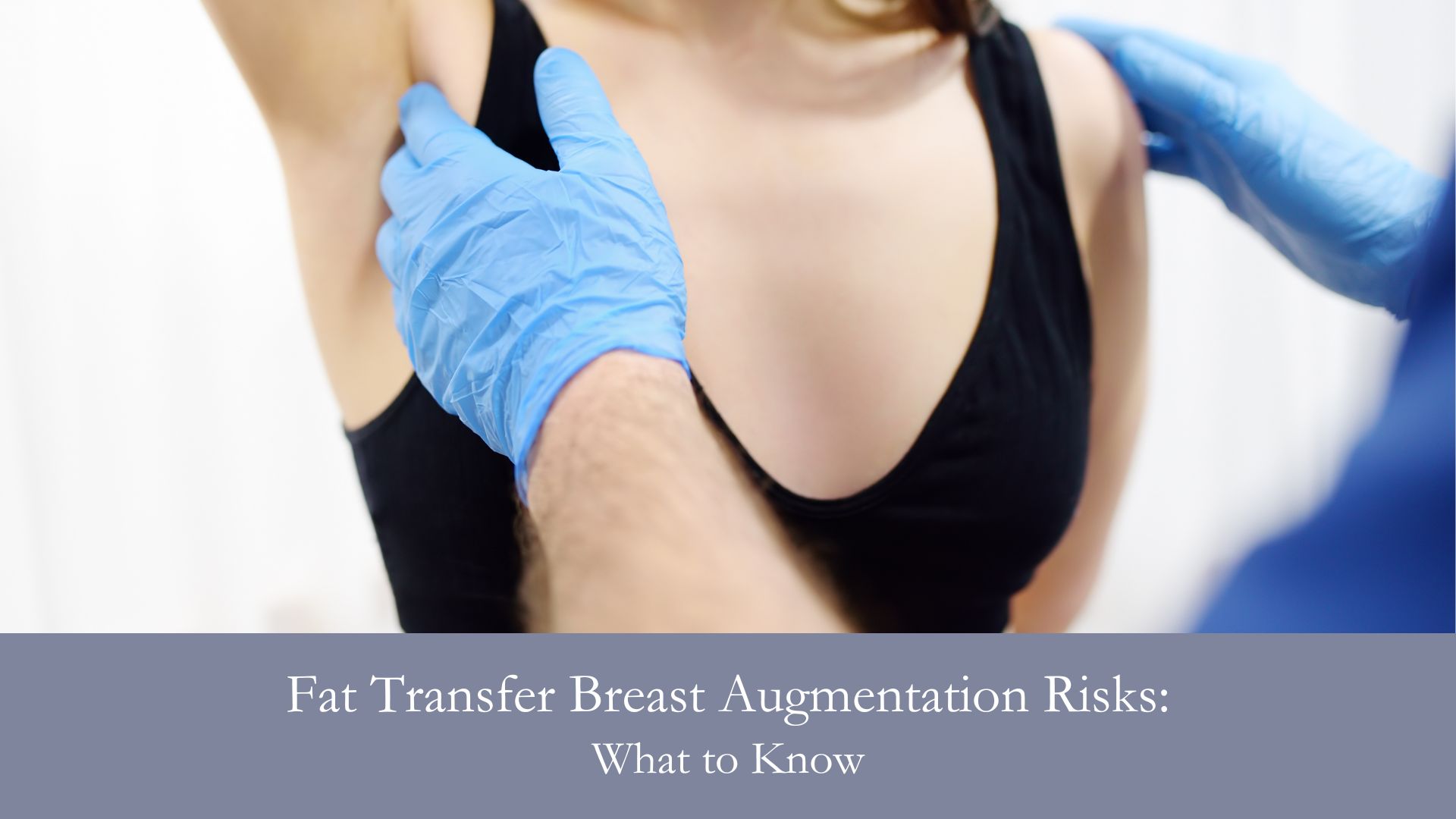A fat transfer breast augmentation is a common choice for people looking to improve breast size and shape without external implants. Instead, the procedure enhances the breast using fat from somewhere else on your body. This gives your breasts a more natural look and feel, especially compared to the feeling of implants. Just like any plastic surgery, there are risks involved, such as fat reabsorption, fat necrosis, and infection. It’s important to understand these risks and make informed decisions under the care of a qualified plastic surgeon.
Table of Contents
About Fat Grafting and Breast Reconstruction Procedures
Fat grafting is a relatively simple procedure that takes a patient’s own fat and transfers it to the breast area to improve breast volume and contour. During the fat transfer breast augmentation, your plastic surgeon will remove fat from donor areas like the abdomen, thighs, or hips via liposuction. The collected fat is purified and reinjected into breast tissue. Another name for this process is called autologous fat grafting or autologous fat transfer.
Patients opt for this method over traditional breast implants if they’re looking to stay away from synthetic implants and want a more natural look, along with breast size enhancement. This type of procedure is common when it comes to breast reconstruction after breast cancer surgery. In some cases, the fat grafting procedure can help correct asymmetry and make previous breast procedures look even better. You can also expect to see an improvement in sagging breasts if you have previously struggled with that issue.
Although many patients seek a subtle increase of about one cup size, results vary depending on the amount of fat available and how much fat survives the transfer. The fat transfer procedure requires the surgeon to be incredibly precise, as the living fat cells need to establish a blood supply in the new area to survive. This process makes fat transfer breast augmentation more complex than a standard boob job with implants, and it’s important to understand the potential risks involved.
While often considered an overall safe procedure, fat transfer breast augmentation risks include infection, fat necrosis, and fat reabsorption, all of which can impact the final breast shape and appearance.
Combining Breast Implants with Fat Grafting
Some patients choose to combine breast implants with fat grafting to get fuller results with a more natural look. In this approach, the plastic surgeon inserts the implants to create volume and structure, then uses fat transfer to fine-tune the breast shape.
This method can soften the appearance of implants, improve cleavage, and help the breasts feel more natural. Surgeons often recommend it for breast reconstruction or patients recovering from breast cancer, especially when the skin is thin or tissue is limited.
While combining procedures can improve results, it also increases the risk of complications, such as infection, fat necrosis, and capsular contracture. It also extends the surgery and recovery time. Not every patient qualifies for both procedures, so it’s important to talk to a plastic surgeon about what works best for your body and goals.
Fat Transfer Breast Augmentation Risks
Like any breast surgery, fat transfer breast augmentation carries risks. While most patients heal without significant issues, complications can affect both the outcome and recovery.
Fat Reabsorption
Fat reabsorption also affects results. The body naturally breaks down and absorbs part of the transferred fat, sometimes as much as 50 percent. This can lead to uneven volume or a smaller-than-expected change in breast size and may prompt a second procedure for correction.
Fat Necrosis
Fat necrosis is the most common complication. It happens when fat cells don’t get enough oxygen and die after transfer. This can lead to firm lumps, oil cysts, or visible irregularities in the breast tissue. Some patients feel discomfort or notice hardened spots under the skin, which may require additional treatment or imaging.
Cysts and Lumps
Lumps or small oil cysts can form after fat transfer breast augmentation, usually due to fat necrosis. When some transferred fat cells don’t survive, the body may form firm nodules in the breast tissue.
These cysts are typically harmless but can affect appearance or cause mild discomfort. Surgeons reduce this risk by using careful injection techniques, though complications may still occur.
Infection
Infection, although less common, remains a concern. Bacteria can enter through injection sites or liposuction incisions, causing swelling, pain, or delayed healing. Surgeons typically manage this with antibiotics, but severe cases may require drainage or removal of the affected fatty tissue.
Calcification
Fat transfer breast augmentation can sometimes lead to calcification, where the body hardens areas of dead fat cells. These calcium deposits may feel like small lumps in the breast and can appear on imaging tests.
Calcification can mimic signs of breast cancer on a mammogram, leading to further testing, but it’s harmless. Surgeons aim to minimize this risk by using refined fat grafting techniques and careful augmentation planning.
May Require Additional Fat Transfers
Some patients need more than one fat transfer procedure to reach their desired breast augmentation results. The body can absorb up to half of the injected fat cells, reducing overall volume.
To correct this, surgeons may recommend a second round of fat grafting after the initial plastic surgery has healed. While this approach offers more control over breast shape, it also extends the overall treatment timeline.
Insignificant Change in Cup Size
Fat transfer breast augmentation typically results in a subtle increase. It’s often less than one cup size. Because the body reabsorbs some of the injected fat, the final volume may fall short of the expected result.
Unlike breast implants, fat grafting can’t guarantee a dramatic size change. Surgeons guide patients toward realistic goals based on their body type and the availability of donor fat.
FAQs
Is There an Increased Risk for Breast Cancer After Fat Transfer Breast Augmentation?
Current studies and systematic reviews show no clear link between fat grafting and an increased risk of breast cancer. Ongoing research continues to monitor long-term results.
Can a Fat Transfer Significantly Increase My Breast Size?
A fat transfer can improve volume, but the results are modest. It doesn’t provide the dramatic increase that implants can offer.
Where is the Fat Usually Taken From?
Surgeons harvest fatty tissue from areas such as the abdomen, flanks, or thighs. A plastic surgeon will make this decision depending on the patient’s body composition and the amount of available fat.
Who is Not a Good Candidate for a Fat Transfer Breast Augmentation?
Most people with very low body fat or those with certain medical conditions may not be eligible for autologous fat procedures. They should consider alternative augmentation options.
Ready for Your Fat Transfer Consultation?
Explore your options with a personalized consultation at Zahedi Plastic Surgery in Fort Lauderdale. Dr. Zahedi will walk you through the fat transfer procedure, answer your questions, and help you understand what’s possible for your breast augmentation goals. Contact us today to schedule your consultation and be one of our next satisfied breast augmentation patients.




